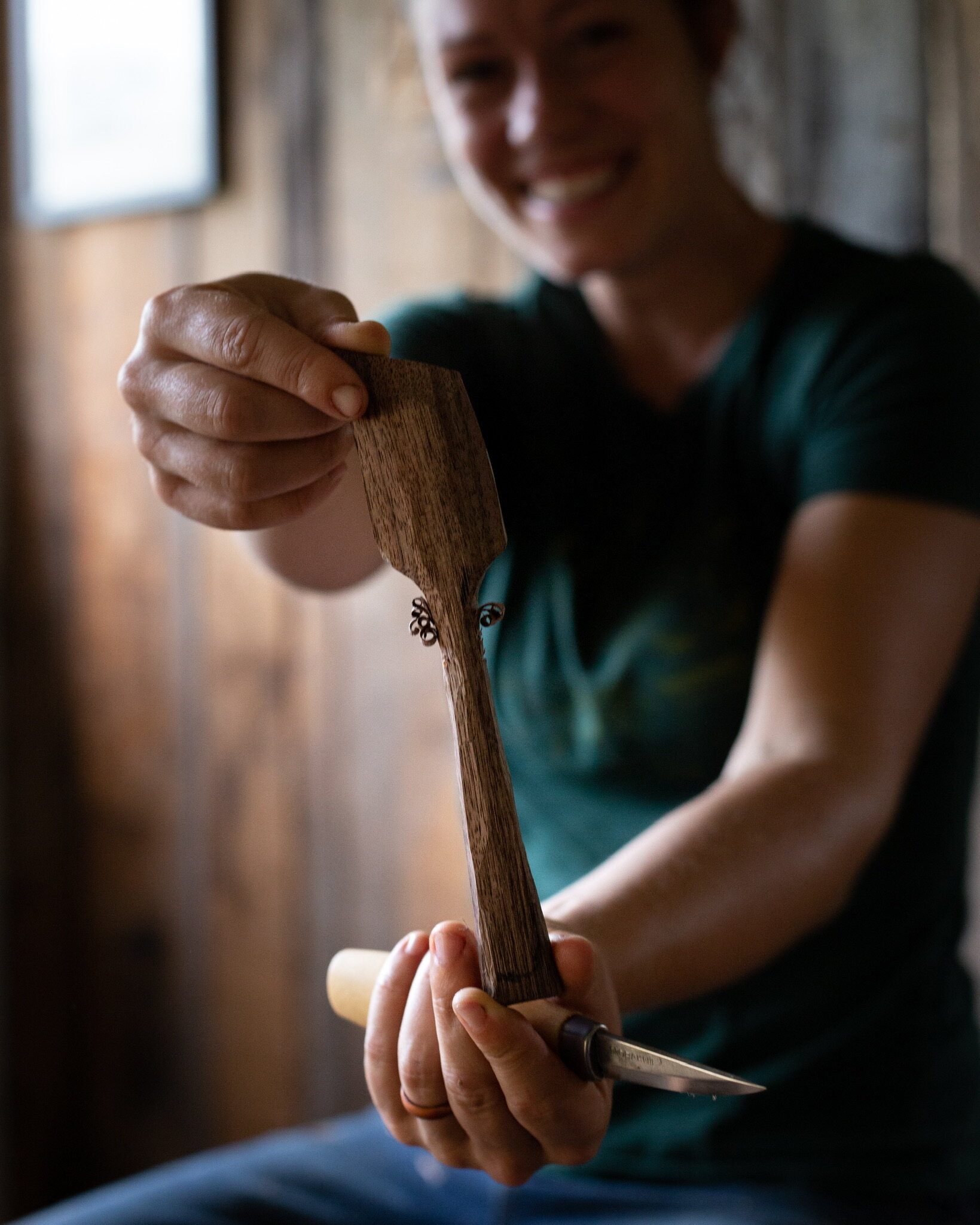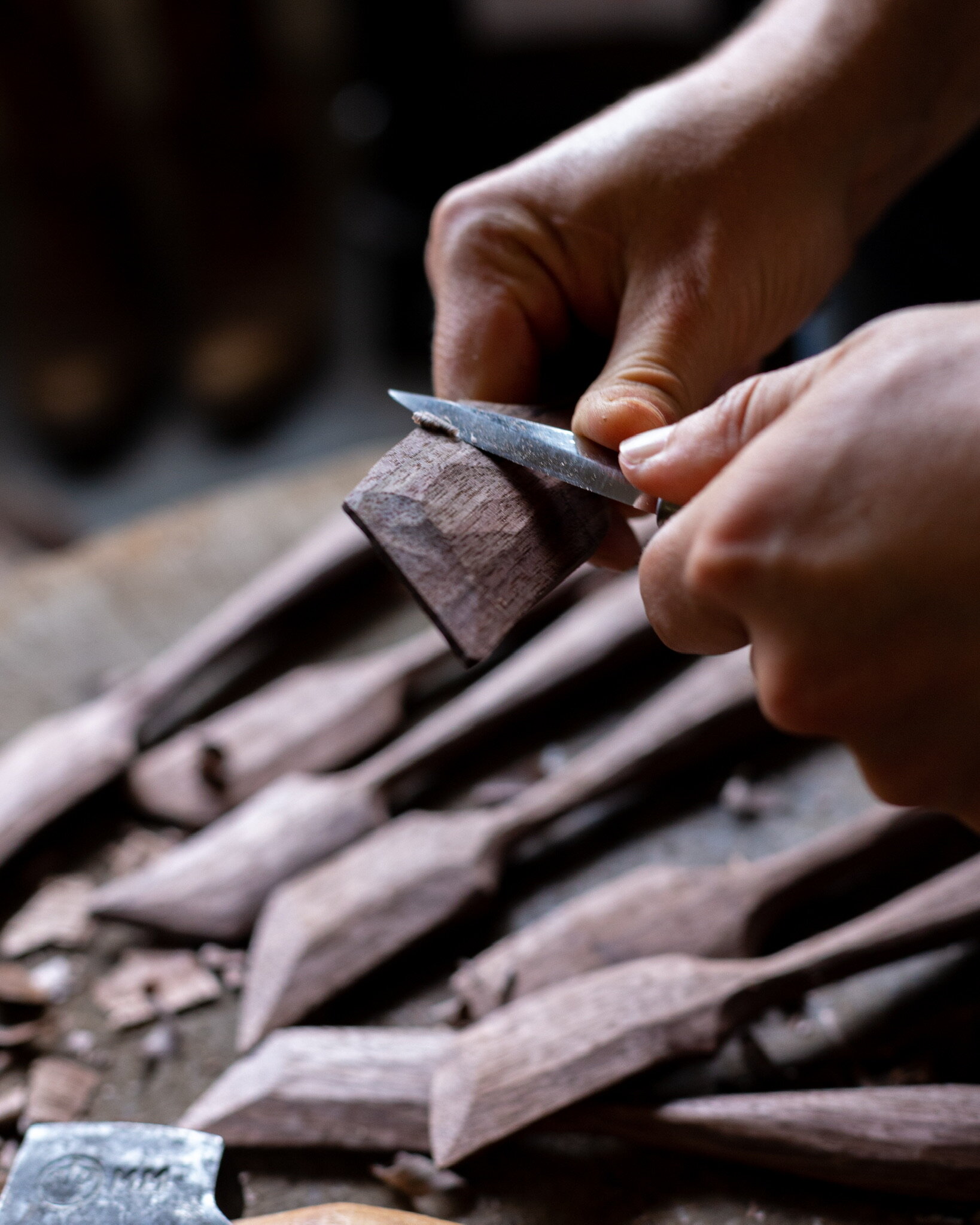21 Questions EVERYONE asks about Spoon Carving
1. What wood do you use?
You can use any freshly cut wood. I love cherry wood, fruit, wood, walnut. But really, if it's been freshly cut or blown down in a storm recently, and it recently was alive, it's going to be great to carve.
2. Where do you get your wood?
You can call your local arborist. You can ask your neighbor when they're trimming their tree. You can go out after a windstorm. If you live by an orchard, you can ask them when they prune their trees and if you can you come and get some for free when they do.
3. How big does the wood need to be?
I like to carve pieces that are about the diameter of a football or bigger. It needs to be wide enough that you can split it in half and take out the pith, or the center of the piece of wood- that is where the most tension lives in the wood, and if you leave it in, your spoon will be much more prone to warping and cracking as it dries.
4. Do you Carve wet or dry wood?
We want wet, or green wood for carving (it has to have been recently cut down).
5. Why not dry wood?
You actually can carve dry wood but it is a lot harder to carve. As the moisture content leaves the wood, the wood hardens and becomes increasingly difficult to carve, and is a lot harder on your blades, so they dull quicker.
6. How do you dry it once you've carved it?
Once you've carved it actually dries really really quickly- within 2-3 days (if you’ve carved it thin enough). So if I have a finished, carved spoon, or gotten it close to being finished, I'll just either toss it down in the shavings on the floor or put it in a paper bag with some shavings and then let it dry out naturally, it should only take about two or three days.
7. What tools do I need to carve with?
You can carve almost anything flat with a sloyd knife. -It's a little bit different than a pocket knife. But you can get away with just about any pocket knife when you're first getting started. Once you get into carving a little bit more you’ll want either a bent gouge, a hook knife, or a scorp. Eventually, you're gonna want a saw. A saw can actually help you fetch the branches and do some other little things that you know you might need to do, and then you can get a hatchet, maybe a froe too. But really, if you have an axe and a knife you can make almost anything with free wood.
8. Your knives seem really sharp! Can I Dull them to Make Them safer?
Dull knives, contrary to human logic are actually much more dangerous than sharp knives, the sharper the knife, the less force you need behind it and the lower the likelihood that you'll actually cut yourself. Dull knives = more force needed, less control over the tool, accidents are much more likely.
9. How do I know if my knives are sharp enough to carve safely?
A lot of people like to use a piece of paper or to shave their arm hair to test the sharpness of their knives, but really, if you're cutting wet wood and it's not kind of butter-like, if it's not like carving a hard cheese or or an unripe pear, then you probably need to sharpen your knife. Also, if your knife is leaving a lot of little ridges in your wood as you're carving, that's another sure sign that it’s time to sharpen it.
10. Are my knives ready to use once I buy them?
Depends on where you buy them from- but it’s pretty safe to say that you should be able to use a knife out of the box for your first five or six spoons before it’s too dull to continue using safely.
11. how do I use a knife?
There are five basic cuts you can learn to keep you safe. The power cut, the chest lever grip, the pull cut, the thumb lever cut and the scoop cut. You can see all five cuts in this video.
12. How long should it take me to carve my first spoon, like 30 minutes?
My first spoon took me about nine hours to carve. I had no idea what I was doing. We build our speed basically by practicing. I know that's not super exciting to hear, but it’s the truth.
13. What if I can't use all the wood I get at once?
I generally get my spoon wood a whole tree at a time, rather than a small chunk at a time. So if I'm not able to use all of my carving wood right away, I’ll saw it in 6 foot lengths and paint the ends with old latex paint or a product like arbor seal. If I think I can get it out later, I’ll toss the logs in the pond. If I’ve got smaller chunks, tossing it in a plastic bag will help retain the moisture. If there's space in the freezer, I'll process as much of the wood as I can into ready to carve spoon “blanks” put those in a bag, and store them in the freezer until I’m ready to carve.
14. Why make a wooden spoon, when you can just buy them super cheap?
You get the reward of doing something with your hands, of turning firewood into useful items for your home!
15. How do you design a spoon?
This sounds pretty silly, but I usually let the wood tell me what the spoon wants to look like. A good way to do it is to divide your piece into three. The bowl wants to take up one part of the three and the handle wants to take up the other two parts of the three. The bowl of the spoon usually wants to look like an egg.
16. How do you carve in three dimensions?
Actually, I don’t. I think of carving like I think of cookie cutters. I first start in one dimension, and then I make the first dimension the shape that I want looking at it straight on. And then I carve it to that second dimension after I've got that initial shape. Then, I make the two dimensions meet by blending all the lines together. And voila! A 3 dimensional object appears.
17. How do I know when I need to sharpen my knife?
If it starts to be really noticeably difficult to carve or if your knife is leaving little ridges or scratches on the wood as you carve, it’s time to sharpen.
18. How do I sharpen my knife?
You can use a series of sharpening slips that you can make yourself, followed by a strop. If you sharpen regularly, you can get away with using just a strop, which is a piece of leather, attached to a flat stick with some kind of honing compound ingrained in the leather. I would definitely recommend taking a sharpening class or at least watching one of my videos on sharpening.
19. Should I sand my spoon when I'm finished?
Ideally, we're going to build up our skill set so that we can carve a finished spoon right off the knife and avoid having to sand. But sometimes there are really tricky bits that just don't want to cooperate. And so you can sand, but I really like to leave the knife cuts visible on my spoons, because if we're going to sand it to make it perfect and machine smooth, why wouldn't we just use machines to carve it in the first place?
20. What do you finish it with?
Walnut oil or any kind of other cooking oil that is not going to go rancid. So you can use coconut oil, but not olive oil. Can I put these in the dishwasher? I wouldn't recommend it. Water, heat and wood utensils don't always mix. However, you can wash it by hand, dry it immediately, and re-oil it on occasion.
21. Why are axes and chainsaws so intimidating?
Just like any cutting tool, it’s all about learning proper body mechanics and understanding the full path of the tool and how to keep your soft bits out of the blade. More on that later!





